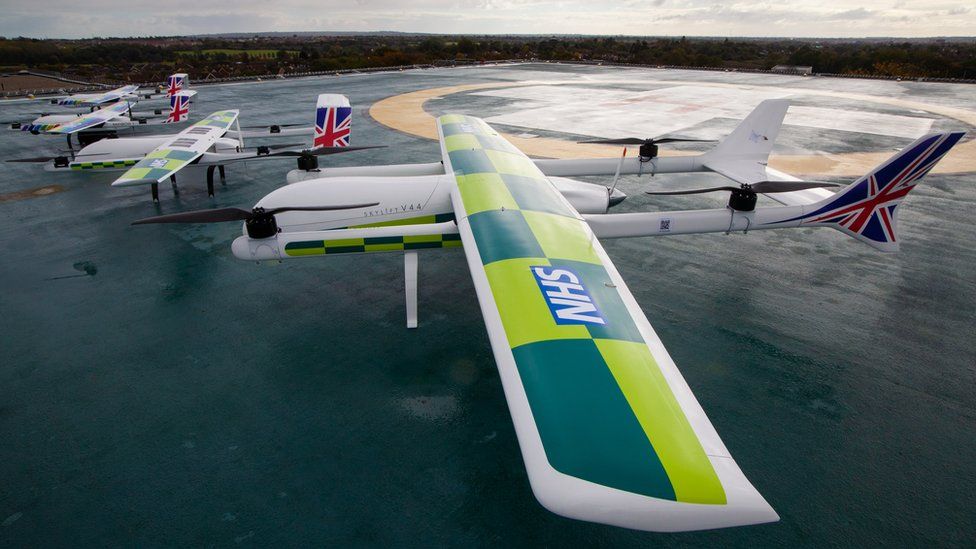UK set to have world’s biggest automated drone superhighway
![]()
UK set to have world’s biggest automated drone superhighway
By Tom Gerken
Technology Team
- Published23 hours ago
- commentsComments
Share

The UK is set to become home to the world’s largest automated drone superhighway within the next two years.
The drones will be used on the 164-mile Skyway project connecting towns and cities, including Cambridge and Rugby.
It is part of a £273m funding package for the aerospace sector which will be revealed by Business Secretary Kwasi Kwarteng on Monday.
Other projects include drones delivering mail to the Isles of Scilly and medication across Scotland.
Mr Kwarteng is to announce the news at the Farnborough International Airshow – the first to be held since 2019.
He will say the funding will “help the sector seize on the enormous opportunities for growth that exist as the world transitions to cleaner forms of flight”.
Potential uses
Dave Pankhurst, director of drones at BT, told the BBC that Skyway is about scaling up trials that have been taking place around the UK.
BT is one of the partners involved in the collaboration.
“This drone capability has existed for quite some time, but is in its infancy in terms of being actually part of our society and being a usable application,” he said.
“So for us, this is about taking a significant step towards that point. It’s going to open up so many opportunities.”
Skyway aims to connect the airspace above Reading, Oxford, Milton Keynes, Cambridge, Coventry and Rugby by mid-2024, and will receive more than £12m.
A total of £105.5m of the government’s funding will be specifically for projects relating to “integrated aviation systems and new vehicle technologies”, including unmanned aerial vehicles (UAVs) such as drones.
These projects include a plan to use drones to provide regular deliveries of mail and medicine to the Isles of Scilly, and to distribute medicines across Scotland, potentially enabling some cancer patients to be treated in their local community.

Chris Forster, chief operating officer of aviation technology company Altitude Angel, said there were a lot of potential uses for the superhighway.
“Whether it be a business doing logistics, all the way to the police and medical deliveries of vaccines and blood samples, there’s a real demand to have access to this airspace,” he said.
“We’ve done a few projects in Africa where the road infrastructure was not good for ground vehicles, and the delivery of vaccines was provided by automated drones.”
Safety and acceptance
The technology utilises ground-based sensors installed along the highway which provide a real-time view of where drones are in the airspace.
This data is then analysed by a traffic management system – a sort of air traffic control for drones – which guides them along their routes and avoids collisions.
Steve Wright, associate professor in aerospace engineering at UWE Bristol, said the biggest concern regarding crashes does not come when the drone is in the air, but during take-off or landing.
“It’s about the first and last bit of the flight,” he said. “The problem is what happens when you’re 10 feet away from people. That’s the bit I spend my time worrying about.
“When it’s up in the air I know it’s stable and it’s not going to hit something.
“People are looking at lowering packages down

































![Lieutenant-Colonel Robert Rogers (7 November 1731 – 18 May 1795) was a British Army officer and frontiersman. Born in Methuen, Massachusetts, he fought in King George’s War, the French and Indian War and the American Revolutionary War. During the French and Indian War, Rogers raised and commanded Rogers’ Rangers, a ranger unit trained for carrying out asymmetric warfare.[2][3](https://www.cowboyron.com/wp-content/uploads/2022/05/1262463_580743685323360_2133853937_o1-1-150x150.jpg)
















![Billie Joe Armstrong & Norah Jones – Silver Haired Daddy Of Mine [Music Video]](https://www.cowboyron.com/wp-content/uploads/2022/11/Al_St._John1-100x100.jpg)























